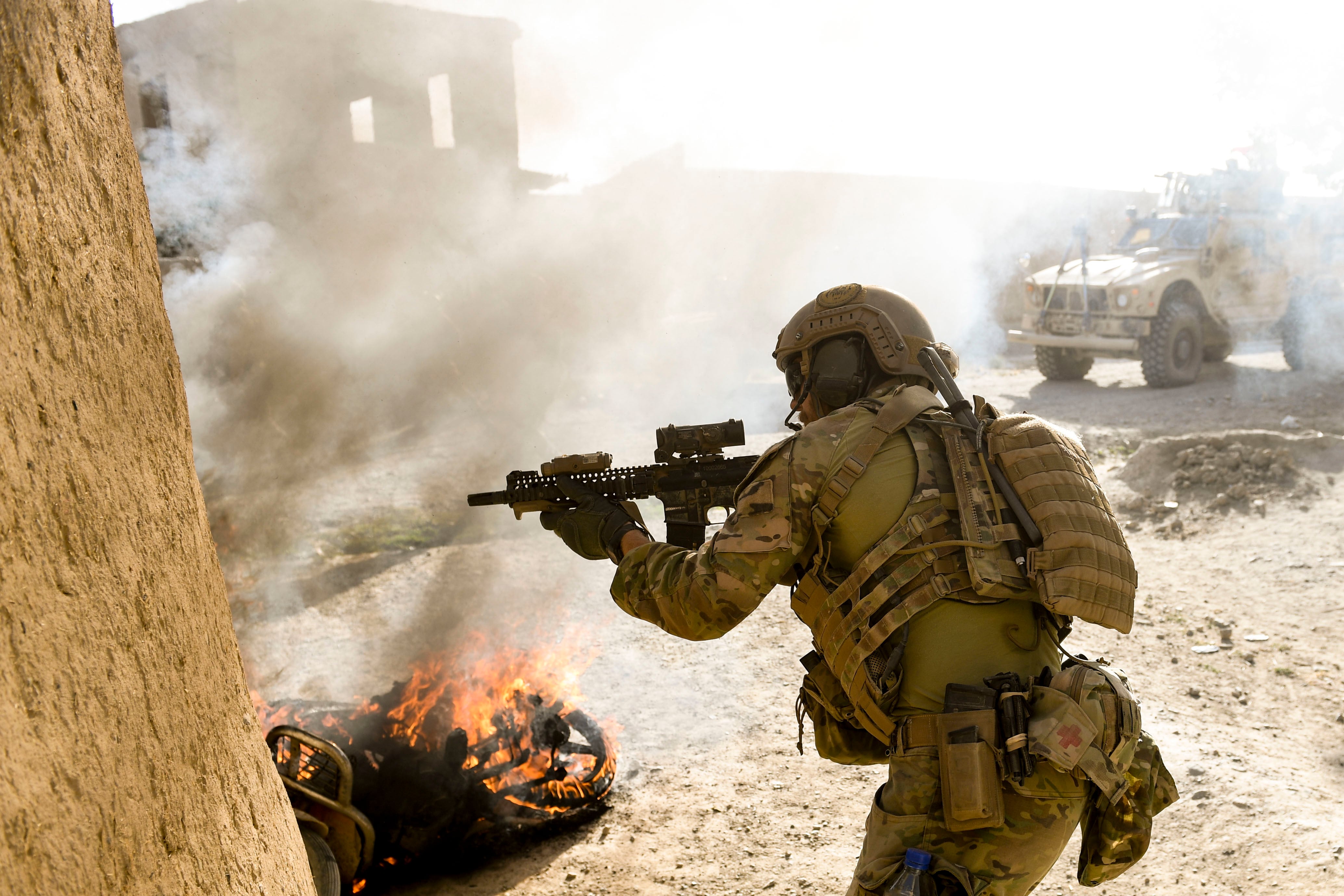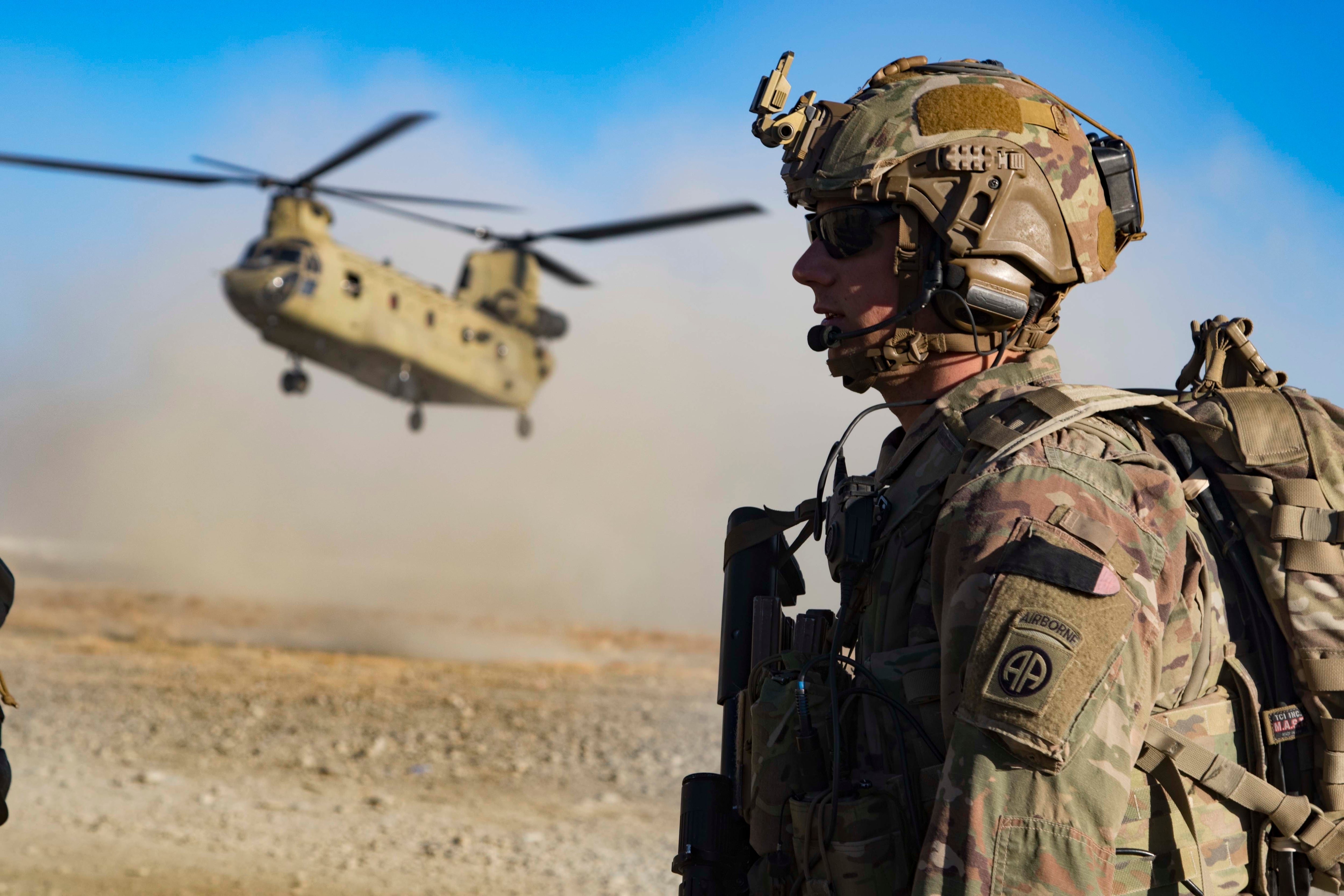Secretary of Defense Mark Esper told lawmakers Wednesday that the Taliban were not honoring their part of a deal inked Feb. 29 with the U.S. following a recent spate of violence across Afghanistan.
The agreement between the Taliban and the U.S., just four days old, is already under pressure as American warplanes swept into Helmand Wednesday to bail out Afghan security forces three days after the insurgent group announced the resumption of attacks.
Esper said that the Taliban were honoring the agreement in terms of “not attacking U.S. and coalition forces, but not in terms of sustaining a reduction of violence."
Following the American airstrike, Taliban spokesman Muhammad Suhail Shaheen responded that the Taliban will “implement all parts of the agreement” to de-escalate the war, but he called on other parties in the conflict to “remove the barriers” for implementing the agreement.
The U.S. attempted to end its 18-year long war in Afghanistan in a four-page deal with the Taliban that includes language as ambiguous as America’s reasons for slogging through gunfights across Helmand’s sparsely populated rural farmlands.
Confusion surrounding the peace agreement appears to center on a Taliban commitment to reduce violence across the country, but no terms related to violence reduction or a cessation of hostilities can be found in the text of the four-page deal inked in Doha, Qatar, on Saturday.
One vaguely-crafted line in the agreement may hint at violence or attack reduction against coalition and partner forces: The “Taliban will prevent any group or individual in Afghanistan from threatening the security of the United States and its allies.”
But that line may also be a reference to America’s desire that the Taliban continue to fight ISIS and sever connections to al-Qaida.
RELATED

There’s also a brewing disagreement between Kabul and the Taliban over an exchange of prisoners that threatens to derail the entire deal.
But U.S. officials have argued that the Taliban have agreed to resume violence reduction beyond the seven-day trial period that ended on Feb. 29 and led to the U.S. signing an agreement with its longtime foe.
The Taliban demonstrated its fighters could reduce violence during an interim peace period that lasted from Feb. 22 to Feb. 29.
Army Gen. Mark Milley, the Joint Chiefs chairman, said at the Senate Armed Services Committee hearing held with Esper Wednesday on Capitol Hill that violence carried out by the Taliban over the last 24 to 48 hours were “smaller lower level" attacks on checkpoints.
Milley explained to lawmakers that the Taliban had “signed up to” not attacking provincial capitals and coalition or U.S. forces, launching attacks in Kabul, and carrying out high-profile and suicide attacks.
However, the details described by Milley Wednesday are not articulated in the publicly-available four-page agreement signed in Doha. Those commitments were, however, part of the seven-day reduction-in-violence trial period prior to the signing of the deal with the Taliban.
On March 1, Secretary of State Mike Pompeo said on CBS’ “Face the Nation” that the U.S. has “asked everyone there to reduce the levels of violence.”
The commander of U.S. forces in Afghanistan Gen. Austin “Scott” Miller recently told Afghan-based Tolo News that the Taliban could squander the peace deal if violence across the country is not reduced.
“We have shown restraint," Miller told Tolo News. “The objective here is to lower violence on all sides. The lowering of violence is our expectation."
“The agreement is fragile if the Taliban are not going to lower violence, that causes risk to this agreement,” Miller told Tolo.
Officials from U.S. Forces Afghanistan did not immediately respond to questions about their interpretation of the language.
There is confusion between public statements being made by U.S. officials with regards to Taliban commitments and the actual text of the document, Laurel Miller, a director with Crisis Group, told Military Times.
“There is no declared ceasefire in effect,” she said.
“U.S. officials have said that they expect violence to remain subdued and have delivered clear public messages to that effect but the distinction between a mutually-acknowledged 7-day agreement and one-sided statements of expectations has created a lot of ambiguity,” she explained to Military Times.
Crisis Group is an independent, non-governmental organization that works to prevent wars, according to its website.
Miller said there may be additional information in the classified annexes of the agreement that have not been made available to the public, but she explained that based on the text of the deal the Taliban “are not violating the terms of the agreement by resuming violence.”
There are classified portions of the Taliban-U.S. deal, but Pompeo told CBS recently that the secret portions of the agreement are merely “military implementation documents that are important to protect our soldiers, sailors, airmen, and Marines.”
“There aren’t any side deals,” Pompeo told CBS.

U.S. Reps. Liz Cheney and Dan Crenshaw, a former Navy SEAL, among 20 other lawmakers, sent a letter dated Feb. 26 to Esper and Milley voicing concerns over secret annexes in the Taliban deal.
In the letter, the lawmakers addressed worries that the U.S. may be entering into a deal that could include the creation of a joint counterterrorism force with the Taliban.
During a House Armed Services Committee Hearing on Feb. 26, Esper and Milley said they weren’t aware of details related to secret annexes in the peace deal or the creation of a joint Taliban counterterror center.
“You’re quoting things that I haven’t seen, so as the chairman of the Joint Chiefs of Staff, I will take a rigorous look at whatever annexes are out there,” Milley told Cheney at the HASC hearing.
Shaheen tweeted Wednesday that reports of a classified deal between the U.S. and Taliban were not true. The Taliban spokesman said there is only the publicly available deal and an “enforcement mechanism" document.
Two days after the Taliban inked an agreement with the U.S. — which could see the withdrawal of all American forces from Afghanistan — the Taliban announced it was resuming military operations against Afghan forces.
Since Monday, violence has spiked across the country following a week of relative calm in which Taliban fighters significantly reduced what Milley said was once 125 attacks a day to just 15.
Social media accounts for analysts, government officials and media personalities covering the conflict have provided a daily tally of Taliban attacks since the insurgents resumed their fight against Kabul.
Nasrat Rahimi, the spokesman for the Afghan Ministry of Interior Affairs, tweeted Wednesday that the Taliban have carried out 30 attacks across 15 provinces in the last 24 hours.
Army Col. Sonny Leggett, the spokesman for U.S. Forces Afghanistan, tweeted Wednesday that the Taliban conducted 43 attacks across Helmand on March 3.
U.S. and Afghan officials appeared to have rapidly attributed dozens of attacks to one particular group in a conflict known to involve a number of Taliban splinter and jihadi groups.
The days since the Taliban agreed to cut down on attacks have been marked by rhetoric focused on counting their daily attacks as a means to gauge the group’s commitment to a reduction in violence not specifically articulated in the four-page agreement.
RELATED

Pompeo has cautioned the American people to focus on actions on the ground and not rhetoric emanating from any particular party to the conflict.
“Just watch what really happens. Pay less attention to statements, pay less attention to things people say. Watch what happens on the ground. There’s been a lot of work done at detailed levels about how this will proceed,” Pompeo said Monday during an interview on Fox News’ “Special Report with Bret Baier.”
Esper told lawmakers Wednesday that the Taliban are likely dealing with hardliners complicating efforts to implement the agreement.
There are, however, tangible successes to America’s deal with the Taliban. Afghan government officials are slated to kick off intra-Afghan talks on March 10 with the insurgent group that could lead to a comprehensive cease-fire.
And American troops are in the early stages of drawing down forces in the country, though America’s exit from Afghanistan could be delayed should the peace process stall.
There are roughly 13,000 American troops in Afghanistan. The U.S. is reducing its footprint to 8,600 over the course of the next several months.
Shawn Snow is the senior reporter for Marine Corps Times and a Marine Corps veteran.





